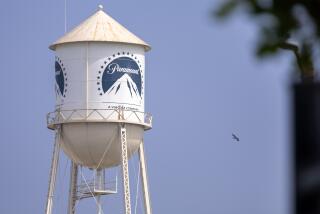National Lampoon Set to Pick a Winner : Publishing Firm Will Choose One of Two Suitors
- Share via
The two investor groups who want to buy National Lampoon Inc., the New York publishing company known for its satirical humor magazine and recent lack of profits, should find out today who gets the last laugh.
Matty Simmons, chairman of the company which also brought America the blockbuster movie “Animal House,” said National Lampoon will announce today the results of its board’s weekend deliberations.
About $160,000 separates the offers, which Simmons described as “friendly.” One investor group, led by 32-year-old Los Angeles entertainment executive Mark E. Shanker, has offered $11.7 million for the company. A separate group, led by Los Angeles broadcasting executive Anthony Cassara, has offered $11.6 million. Neither Shanker nor Cassara have been available to comment on their bids.
Since the offers began surfacing a week ago, Simmons and other members of National Lampoon’s board have been engaged in a constant series of meetings at the company’s fashionable headquarters on New York’s Madison Avenue. The board has already rejected as inadequate a $6.4-million offer from Vestron, a Stamford, Conn., distributor of videocassettes and films. Vestron hasn’t renewed the bid.
Missing from the fray are the nation’s publishing industry giants. “What would National Lampoon do for Time Inc.? It would probably draw a big laugh and kill their stock price,” said Kenneth Noble, a media analyst for Paine Webber in New York. “These entrepreneurial types who are making the bids probably think they can do something with the company that National Lampoon itself couldn’t do.”
Entertainment industry sources said National Lampoon quietly put itself up for sale four or five months ago. At the time, the company said it was looking for a financial partner, but would consider selling the entire company, the sources said.
“They’ve got a great name,” said one entertainment industry source familiar with National Lampoon. “But what else have they got? A magazine that’s losing circulation and a movie business that hasn’t made a successful film in years.”
Simmons, who owns 8.7% of National Lampoon’s shares, bristles when his company is criticized. “These people that are willing to pay millions aren’t dummies,” he said. The company’s film business is profitable, he said, “and there are indications that our magazine business is turning around.”
Wometco Chief a Bidder
Cassara, the former president of Golden West Television, made millions when the company sold Los Angeles television station KTLA Channel 5 to Tribune Co. last year. He is currently the president of Wometco, a West Los Angeles company that operates television stations in Miami and Asheville, N.C.
Shanker, a 1976 graduate of Harvard University and former roommate of a Harvard Lampoon editor, quit his job as an executive vice president at Nelson Entertainment in Los Angeles to make the Lampoon bid. Nelson’s parent, Nelson Holdings of Vancouver, Canada, recently purchased Embassy Home Entertainment home-video company from Coca-Cola.
National Lampoon once reflected the political climate and satirical humor of the 1970s. One of its best-selling covers featured a forlorn-looking mutt with a gun to its head. It read: “If you don’t buy this magazine, we’ll kill this dog.”
Spoofs of Stars
Other spoofs included a parody of Playboy magazine called “Playdead,” featuring a “centerfold” of Marilyn Monroe in rigor mortis, and a supposed question-and-answer session with the late Dan Blocker of the “Bonanza” television series, in which all of the answers were blank.
By 1976, many of National Lampoon’s star writers had moved on to television to write for such programs as “Saturday Night Live.”
Circulation has declined dramatically. Last year, it sold 377,600 copies, down about 15% from 1984. As a result, its advertising rates, which are based on circulation, dropped by 25%.
National Lampoon has lost money each year since 1981. Last year, it lost $750,000 on revenue of $8.6 million. Most of the revenue, about $7.3 million, came from its unprofitable publishing operations. Magazine revenue was down 42% from the $12.5 million National Lampoon took in in 1981, its last profitable year.
Its film business has fared better, but hasn’t been a significant source of revenue. National Lampoon entered the film business with the 1978 “Animal House,” and by December, 1985, its share of that film’s revenue amounted to $10.2 million. The film, which featured the zany antics of college fraternity members and starred the late comedian John Belushi, has grossed more than $200 million in ticket sales, videocassettes and cable television sales.
Three Films Unprofitable
In July, 1985, “National Lampoon’s European Vacation” was released and through the end of 1985, National Lampoon’s share of the revenue was $2.2 million. However, three other films the company lent its name to never earned the company a profit. In an ironic twist worthy of the magazine itself, one unlikely investor is cheering about the takeover bids: Des Moines General Hospital in Iowa, which owns 9.4% of National Lampoon’s 1.6 million outstanding shares. Dennis S. Barsky, vice president for fiscal affairs at the hospital, said it acquired those shares about a year and a half ago at prices ranging between $3 and $4 each. “We believed they were seriously undervalued,” he said. “We thought the shares could go as high as $10. But $7 isn’t bad, is it?”
More to Read
The biggest entertainment stories
Get our big stories about Hollywood, film, television, music, arts, culture and more right in your inbox as soon as they publish.
You may occasionally receive promotional content from the Los Angeles Times.










